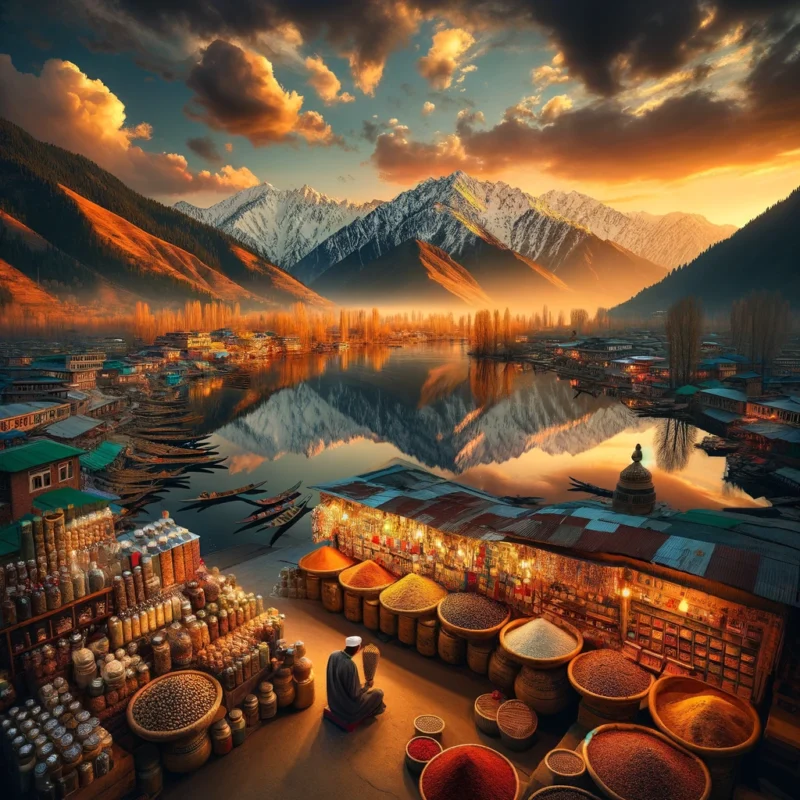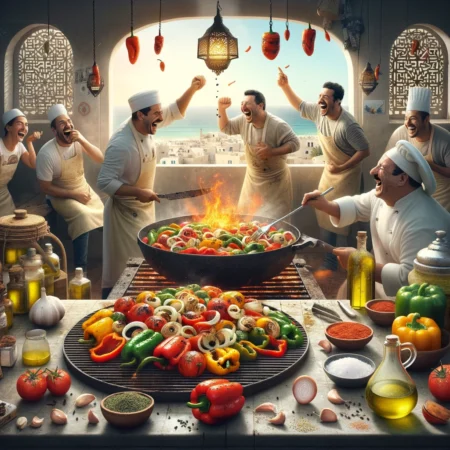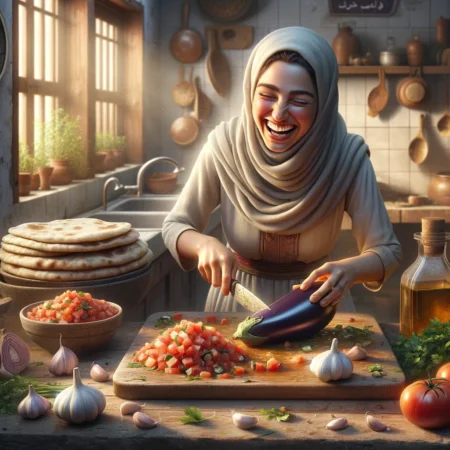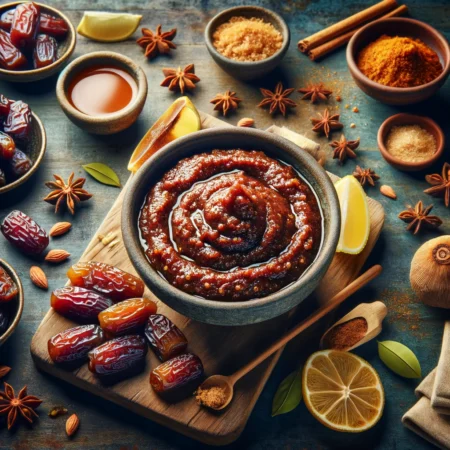The valley of Kashmir, with its sweeping views of snow-capped mountains and emerald-green meadows, is often referred to as ‘Paradise on Earth.’ But beyond its picturesque landscapes and serene houseboats, Kashmir has an essence that murmurs through the ages – its food. And in this culinary tapestry, no thread is as vibrant as the Kashmiri Masala.
Stepping foot in Srinagar, the summer capital of Kashmir is like walking into a canvas painted in hues of gold, green, and white. The air is scented with the mellow aroma of pine trees, the gentle hum of the Jhelum River, and, if you’re fortunate, the distant sound of a Rabab playing a soulful tune. But for a discerning traveler and gourmand like myself, the real draw is the allure of the local cuisine. And that brought me to the doorsteps of Abba’s quaint shop.
Tucked away in a bustling market, away from the main thoroughfare, Abba’s establishment is a treasure trove for spice enthusiasts. Bottles, jars, and sachets filled with spices are stacked from floor to ceiling. And amidst them all, Abba sat, his aged eyes twinkling with mischief and wisdom.
“Ah, you’ve come in search of the soul of Kashmir,” he declared before I could speak a word. “The Kashmiri Masala.”
How did he know? Well, legends are intuitive like that.
Abba’s hands, wrinkled with time and labor, sifted through a drawer and pulled out a small, ornate box. “The history of Kashmiri Masala,” he began, “is as layered as its ingredients. It’s a blend that captures the essence of our land, our history, and our spirit.”
The tale he spun took me back centuries. Kashmir, being at the crossroads of Central Asia and the Indian subcontinent, was a major hub on the ancient Silk Road. Traders, monks, and invaders passed through, each leaving a fragment of their culture and culinary practices.
It was during the reign of the Mughal emperors that Kashmiri cuisine began to take its distinctive form. The royal chefs, under the patronage of emperors who loved the good life, experimented with local ingredients, infusing them with spices brought from Persia, Afghanistan, and beyond. It was in the royal kitchens that the prototype of what we recognize today as Kashmiri Masala was born.
But Abba was quick to point out, “It wasn’t just the Mughals. Our Pandit community, with their strict vegetarian diet, tweaked the masala, adding and removing elements to suit their palate. The nomadic Gujjar and Bakarwal tribes, moving with their herd through the valleys and over the treacherous mountain passes, brought with them secrets of herbs and spices from distant lands.”
The blend itself? A symphony of flavors. The fiery red chilies are reminiscent of the passion of the people and the vibrant houseboats on Dal Lake. The subtle fennel seeds echo the gentle swaying of the Chinar trees in autumn. The sharp ginger embodies the biting cold of a Kashmiri winter. Cardamom, cloves, and cinnamon spoke of romance, poetry, and the lingering notes of Sufi music.
As Abba handed me a sachet of this mesmerizing blend, the aroma immediately enveloped me, rich and heady, yet comforting.
“Every family has its recipe,” he said with a chuckle. “And each one believes theirs is the best.”
Abba’s version? It had a secret ingredient. “Love,” he whispered. “And memories. Memories of ancestors, of festivals, of shared meals, and whispered tales under the winter sun.”
Walking away from his shop, the streets of Srinagar seemed different. They echoed with stories of dynasties, of poets, of lovers, and of ordinary people with extraordinary tales. And in my hand, I held a sachet of that legacy – Kashmiri Masala. The soul of a valley, and the heart of its people.
As the sun set over the Jhelum, casting a golden hue over the city, I realized that spices are not just about flavor. They’re carriers of history, culture, and tales that need to be told. And as I brewed a cup of traditional Kahwa tea, infused with a pinch of masala, I couldn’t help but feel connected to the soul of Kashmir, its whispers echoing through time.
The next time you come across a dish infused with Kashmiri Masala, know that it’s not just food you’re tasting. It’s a story. A beautiful, timeless story.
help me create a recipe breakdown in bullets with measurements to create the above spice blend. Please use the format of the example recipe in the shortcode below:
Pumpkin Pancakes with Apple Compote and Candied Nuts
Ingredients
- 1 cup raw shelled nuts
- 1/4 cup light brown sugar
- 2 tablespoons unsalted butter
- 2 teaspoons rosemary
- 1 teaspoon flake sea salt
- 1/2 teaspoon chili flakes
Directions
- Line a baking sheet with parchment paper and set it aside.
- Melt the butter over medium-high heat in a large frying pan. Add the brown sugar and stir to combine.
- Continue cooking until the sugar melts, about 3 to 5 minutes, stirring every minute.
- Add the nuts and cook until they are toasted and very fragrant, about 8 minutes, stirring every minute.
- If the pan begins smoking, remove it from the heat and stir it until it stops smoking, then place it back over the heat and continue stirring every minute until the nuts are sufficiently toasted.
- Empty the pan contents onto the parchment paper-lined baking sheet and spread the nuts mixture out evenly using a spatula. Immediately sprinkle with the rosemary, salt, and chili. Allow cooling to room temperature.
- Once cooled, break apart any large chunks of nuts into individual nuts and serve.
Tips & Tricks: And the whipped cream rounded out all the flavors and just added a nice and fluffy element to the dish. YUM. I got all my ingredients at New Seasons Market, which is a store local to the Pacific Northwest area that sells a huge array of delicious seasonal fresh produce and all-natural ingredients. You can see if there’s a store near you using their find-a-store locator here.





